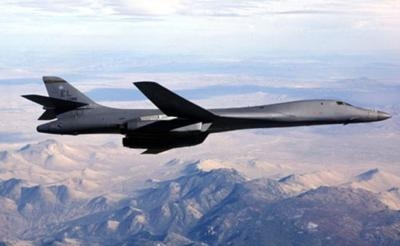Mon, Apr 27, 2015
Changes To Be Effective October 1, 2015
The Secretary and Chief of Staff of the Air Force have directed the realignment of the Air Force’s B-1 bomber fleets and Long Range Strike-Bomber program from Air Combat Command to Air Force Global Strike Command, effective Oct. 1.

The move will realign the Air Force’s core mission of global strike and all of the service’s bombers under a unified command responsible for organizing, training and equipping Airmen to perform this mission.
“This realignment places all three Air Forces bombers under one command and brings the LRS-B program with it,” said Secretary of the Air Force Deborah Lee James. “Consolidating all of our Air Force assets in this critical mission area under a single command will help provide a unified voice to maintain the high standards necessary in stewardship of our nation’s bomber forces.”
Sixty-three aircraft and approximately 7,000 people will transfer from ACC to AFGSC under the realignment. Since moving from Strategic Air Command in 1992, the B-1 has played an essential role in combating the nation’s enemies, either projecting combat power from bases in the United States or from forward operating locations around the globe.
Airmen who drive B-1 operations have demonstrated the platform’s long range strike capability, delivering its conventional weapons on target from home station, making it a perfect fit for joining the B-2 and B-52 under AFGSC, James said.
"With a single command responsible for the Air Force’s entire long range strike fleet, the Airmen in AFGSC will benefit from better coordination and increased sharing of expertise across the five bomber wings,” said Air Force Chief of Staff Gen. Mark A. Welsh III. “Consolidating all conventional and nuclear capable bombers within the same command allows the Air Force to streamline the global strike and strategic deterrence missions, and create a lasting positive impact for the Air Force’s global strike capabilities.”

Both the 7th Bomb Wing at Dyess Air Force Base, Texas, and the 28th BW at Ellsworth Air Force Base, South Dakota will continue to serve as the host wings and provide installation support and services to other units on the bases.
"We expect the transfer to be imperceptible to the majority of Airmen at Dyess and Ellsworth as they will continue to work for the same supervisors and units," said Lt. Gen. Stephen Wilson, Commander, Air Force Global Strike Command who was recently nominated to serve as the vice commander of U.S. Strategic Command at Offutt AFB, Neb.
“The impacts of the realignment will become noticeable over time as crosstalk among maintainers and aviators increases across all three platforms, creating opportunities in training, tactics development, doctrine development, aircraft modernization and acquisition,” Wilson said.
The consolidation of the global strike mission under AFGSC follows the Air Force’s plan to elevate the commander of AFGSC from a three-star to a four-star general officer position, which Gen. Robin Rand, currently the commander Air Education and Training Command, will assume.
(Images from file)
More News
The Industry Continues to be Rocked By Some Questionable Operations Recent investigations and a great deal of data has resulted in ANN’s SportPlane Resource Guide’s rep>[...]
Make Sure You NEVER Miss A New Story From Aero-News Network Do you ever feel like you never see posts from a certain person or page on Facebook or Instagram? Here’s how you c>[...]
Visual Approach Slope Indicator (VASI) An airport lighting facility providing vertical visual approach slope guidance to aircraft during approach to landing by radiating a directio>[...]
Airport Marking Aids Markings used on runway and taxiway surfaces to identify a specific runway, a runway threshold, a centerline, a hold line, etc. A runway should be marked in ac>[...]
Aero Linx: The Skyhawk Association The Skyhawk Association is a non-profit organization founded by former Skyhawk Pilots which is open to anyone with an affinity for the A-4 Skyhaw>[...]
 Unfortunate... ANN/SportPlane Resource Guide Adds To Cautionary Advisories
Unfortunate... ANN/SportPlane Resource Guide Adds To Cautionary Advisories ANN FAQ: Turn On Post Notifications
ANN FAQ: Turn On Post Notifications ANN's Daily Aero-Term (04.29.24): Visual Approach Slope Indicator (VASI)
ANN's Daily Aero-Term (04.29.24): Visual Approach Slope Indicator (VASI) ANN's Daily Aero-Term (04.28.24): Airport Marking Aids
ANN's Daily Aero-Term (04.28.24): Airport Marking Aids ANN's Daily Aero-Linx (04.28.24)
ANN's Daily Aero-Linx (04.28.24)




